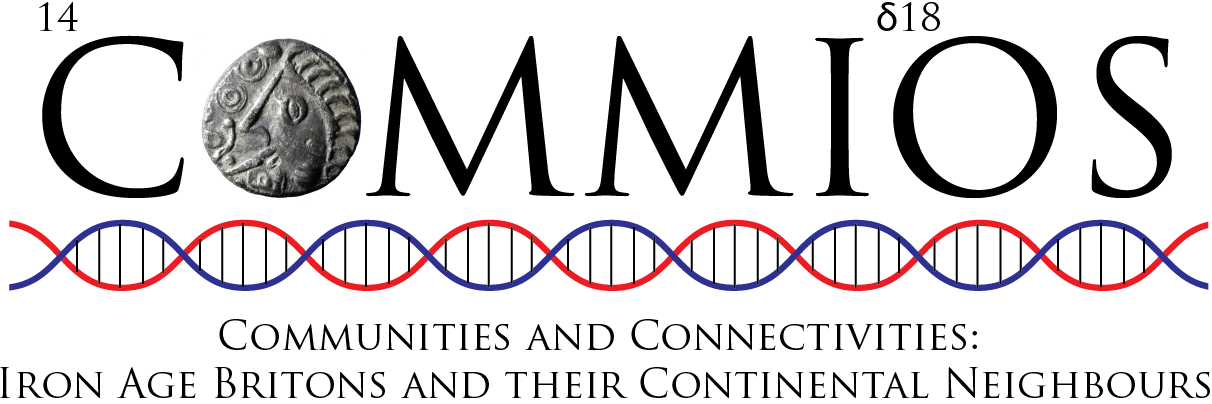Been for a walk recently? Have you ever stopped for a moment and thought about what’s under your feet? Well, as an archaeologist I think about this quite a lot. And while I still dream about discovering a warrior burial, these days I’m equally keen to investigate the types of rocks that lie under my feet.
But what has the COMMIOS Project got to do with rocks?
The COMMIOS Project is all about investigating connectivity during the Iron Age so an important part of our work is trying to figure out where people lived and how they moved throughout their lifetime. One way archaeologists can study past mobility is by measuring the isotope ratio of strontium in ancient bones and teeth.
Strontium (Sr) is a trace element found in rocks which is eroded out into soil/water and then taken up by plants. The strontium then becomes incorporated into the food chain and replaces calcium in the bones and teeth of animals. Through this process, humans end up with a chemical signature reflecting the local geology. For mobility studies in archaeology, we’re interested in two isotopes of strontium (87Sr and 86Sr) because the amount of 87Sr varies according to the type of rock (older rocks have higher amounts of 87Sr in relation to 86Sr than younger ones). We can therefore look at the isotope values for strontium in human teeth to explore past mobility.
This method can tell us about mobility throughout a person’s childhood/adolescence depending on what is analysed – because teeth form at different times as a person grows. I usually work with enamel from human 2nd molars which is formed when a person is around 3-6 years old. Other teeth (incisors/canines) form earlier, while the enamel of human 3rd molars (wisdom teeth) forms when a person is 9-15 years old. The strontium ratio of enamel reflects what a person consumed during the time their tooth formed, and by extension, provides information about where they grew up. For example, if an Iron Age adult warrior was buried in a location with older rocks but their enamel strontium values are similar to those of younger rocks then we know they didn’t grow up where they were buried, in other words, they’re “non-local”. We can then look at geological maps and isoscapes to investigate where they may have lived as a child. In reality, it is not as simple as matching a human value to a map (I will leave that for another time!) but nevertheless strontium isotope analysis remains a powerful tool for studying prehistoric mobility and migration.
In November I spent three days at the British Geological Survey (BGS) in Keyworth working on ancient human remains sampled for the COMMIOS project. The individuals were excavated from several sites, ranging from a Broch in Orkney to an Iron Age cemetery in Alderney. During my visit to the BGS I worked with Professor Jane Evans who is a leading expert in isotope geochemistry and strontium biosphere mapping. Her research uses these methods to reconstruct residential origins, mobility and diet.
Over the three days I was trained how to prepare samples for strontium isotope analysis: drilling/cutting teeth to remove a fragment of enamel, cleaning the enamel to remove contaminants, dissolving samples in acid and, finally, extracting the strontium using ion chromatography. For this final step, samples pass through columns filled with a special resin (cation exchange resin) and collected. The strontium fraction is then dried down in preparation for mass spectrometry.

One of the highlights of my trip was shadowing BGS researcher Doris Wagner as she prepared the samples for the Thermal Ionization Mass Spectrometer (TIMS for short!) It’s a process that has to be done very carefully: samples are pipetted onto small metal filaments (Image 2A), heated, put into a turret (Image 2B) and then loaded into the machine (Image 2C). Once loaded into the machine, an electric current is passed through the filament, heating it up and causing the sample to ionise (a process called “thermal ionisation”) (Image 2D shows a glowing filament). The ions are then separated by mass, collected and detected.

I’m looking forward to seeing what the strontium will reveal about where these Iron Age individuals spent their childhood. We will also be measuring the oxygen isotope composition of the enamel samples (I’ll explain what oxygen can tell us in another post!). We’ll then compare the isotope results with genetic data, funerary practices, and archaeological evidence for trade and mobility. All this information will help us piece together where these people grew up, if they moved throughout their lifetime and whether their genetic ancestry suggests they may have originated outside of Britain. This will feed into bigger studies on genetic diversity of Iron Age populations and provide new insights into mobility patterns.
Overall, I had a great time at the BGS and I am looking forward to returning there soon!

